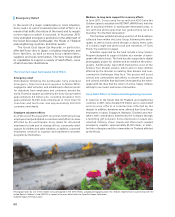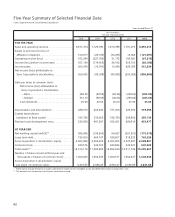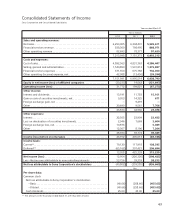Sony 2012 Annual Report Download - page 57
Download and view the complete annual report
Please find page 57 of the 2012 Sony annual report below. You can navigate through the pages in the report by either clicking on the pages listed below, or by using the keyword search tool below to find specific information within the annual report.
Environmental Activities Focusing on the Product Life Cycle
Research and Development
Focusing on electrical outlets, a crucial component of the
infrastructure through which electricity is consumed, Sony is
promoting the development of “authentication outlets” that
make use of its contactless IC card technology. With these
outlets, an IC chip is mounted in the plug of a home appli-
ance, electric vehicle or other electrical device, while an IC
card reader/writer is embedded in the appropriate electrical
socket. When the device is plugged in, the outlet “authenti-
cates” the device and its owner and transmits the correct
amount of electricity. In ad-
dition to facilitating the cal-
culation of per-user electric-
ity consumption and
monitoring the electricity
use of individual devices,
these outlets are expected
to find application in the
construction of new elec-
tricit y ser vices and home
energy management systems
(HEMS).
Product Planning and Design
In February 2011, Sony developed SoRPlas (Sony Recycled
Plastic), which uses more than 99% recycled materials, giving
it the highest recycled materials rate among plastics in the
world.* SoRPlas also has flame-retardant properties. SoRPlas
is made from the rec ycled polycarbonate waste plastic
collected from within and outside the Sony Group and blended
with a new flame retardant containing sulfur, which Sony
developed at its own laboratories. Sony expects SoRPlas to
achieve an estimated 80% reduction in CO2 emissions in the
plastic manufacturing process (including transportation) com-
pared with conventional plastic. Beginning with the screen
frame component of three BRAVIA™ LCD television models
launched in spring 2011, Sony has expanded its category of
products using SoRPlas to include 3D Handycam® camcorders
and Cyber-shot™ compact digital cameras, among others.
* Based on Sony research as of February 2011. Conventional flame retar-
dant recycled plastics used in electronics products have a recycled
content ratio of less than 60%.
Procurement*1
With regard to designated chemical substances contained in
products and parts, Sony has formulated its own set of stan-
dards for managing chemical substances, which reflect both
global legal mandates and the views of its stakeholders, in
order to comply with the EU REACH*2 regulation and the RoHS
Directive*3, among others. Sony also operates its own Green
Partner Environmental Quality Approval Program and other
systems that reinforce its ability to ensure the appropriate
management of chemical substances in use. Sony also keeps
a close watch on related supply chain issues, including
monitoring greenhouse gas emissions of its principal manu-
facturing outsourcing partners.
*1 Please refer to pages 50–51 for more details.
*2 REACH (Registration, Evaluation, Authorisation and Restriction of
Chemicals): Regulations introduced in the EU for managing chemical
substances
*3 RoHS: Directive on the restriction of the use of certain hazardous sub-
stances in electrical and electronic equipment
Operations
Sony sets a variety of environmental targets including abso-
lute targets on greenhouse gas emission and waste reduction
on a unified global basis and takes a proactive approach to
reducing the environmental footprint of its factories and
oces worldwide, as well as pursuing environmental contribu-
tion activities that suit the needs of the surrounding local
community. In fiscal year 2011, Sony began implementing the
Green Star Program, its own environmental performance
assessment program. This program provides a comprehensive
evaluation of the environmental initiatives of each Sony
Group site based on common standards, with a view toward
helping to improve the eectiveness of such undertakings.
Logistics
Sony is decreasing gross transportation weight by reducing
the weight of finished products. At the same time, Sony is
striving to reduce the volume of packaging materials and CO2
emissions derived from logistics operations through optimiz-
ing transportation eciency (i.e., size reduction and modular-
ization of product packaging to optimize load eciency) and
shifting to alternative modes of transportation that pose less
environmental impact.
Take-back and Recycling
Sony recognizes its social responsibility as a manufacturer
and adheres to the recycling laws and regulations of the
countries and regions in which it operates by promoting the
take-back and recycling of end-of-life products. At the same
time, Sony also actively conducts voluntar y take-back
initiatives, even in regions and countries—such as some
countries in South America—that have not yet introduced
recycling laws or regulations. The end of analog broadcasting
and the eco-point scheme in Japan were contributing factors
to the reduction of end-of-life products collected in fiscal year
2011 compared to the previous fiscal year.
200
Americas
Europe
apan
200200200 2011*2
2010
112
1
3
1
120
(F)
Weight of End-of-Life Products Collected*1
(Thousands of tons)
55
*1 Data from regions not mentioned are also included.
*2 The FY2011 figure for Europe does not include Belgium,
the Netherlands, Hungary and Switzerland.
Authentication outlet
























